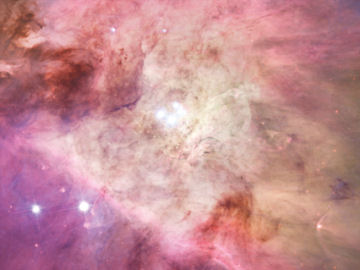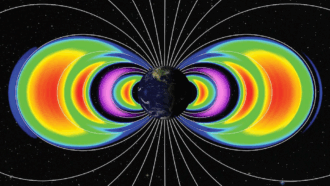Sun Beating
When our sun was very young, a huge, exploding star roughed it up.
Share this:
- Share via email (Opens in new window) Email
- Click to share on Facebook (Opens in new window) Facebook
- Click to share on X (Opens in new window) X
- Click to share on Pinterest (Opens in new window) Pinterest
- Click to share on Reddit (Opens in new window) Reddit
- Share to Google Classroom (Opens in new window) Google Classroom
- Click to print (Opens in new window) Print
By Emily Sohn
Getting bullied is no fun, but it still happens sometimes—even to the sun. When our sun was very young, a huge, exploding star gave it a beating, according to new research. The solar system hasn’t been the same since.
 |
|
The area of the Milky Way seen here, which scientists have nicknamed the Orion star-making factory, is one of the places closest to Earth where new stars are born. Evidence suggests that the sun was born in such a factory and that a massive neighbor exploded soon after the sun’s birth. |
| M. Robberto, NASA, ESA, HST Orion Treasury Project Team |
Researchers from the University of Copenhagen in Denmark made the discovery while trying to figure out how much iron existed in the early days of our solar system. To do this, they looked at eight meteorites formed at different times during the 3 million years after the birth of our sun and the solar system’s planets.
In meteorites, a form of iron called iron-60 gradually turns into nickel-60. So, the researchers measured nickel-60 in all eight meteorites. They found that the younger meteorites contained far more nickel-60 than the older ones did. The oldest meteorites formed in the first million years after the solar system was born.
Only a supernova—the spectacularly exploding death of a giant star—could have produced the original iron-60 that eventually became the nickel-60 in the younger meteorites, scientists say. All the meteorites studied, on the other hand, contained about the same amount of aluminum. A supernova would not be necessary to supply the objects with that metal.
“This is a convincing argument that you had an injection of iron-60 about 1 to 2 million years after the birth of the sun,” says Steve Desch of Arizona State University in Tempe. The only source for that iron “that makes any sense whatsoever is a nearby supernova,” he adds.
A longstanding theory says that our sun formed when a nearby supernova triggered the collapse of a cloud of gas and dust. The new discovery challenges that theory. Instead, it suggests, our sun formed about a million years before that supernova.
Calculations show that the massive star that exploded was about 30 times as heavy as the sun. And it was relatively close to the sun—only about a light-year away. At first, the big star pummeled our sun with fierce winds. Then, when it exploded, it pounded our star with shock waves, driving iron into both the sun and the budding planets around it.
Huge stars often form as part of star clusters. This study suggests that our sun formed alongside thousands of others, including the one that exploded nearby, some 4.5 billion years ago.
How did our sun survive such a battering? Because newborn stars are tough. In fact, theorists say, such a star could survive a supernova as close as just a third of a light-year away.—Emily Sohn
Going Deeper:
Cowen, Ron. 2007. Violent past: Young sun withstood a supernova blast. Science News 171(May 26):323. Available at http://sciencenews.org/articles/20070526/fob1.asp .
Sohn, Emily. 2006. Dead star exploding. Science News for Kids (Aug. 9). Available at http://www.sciencenewsforkids.org/articles/20060809/Note2.asp .






